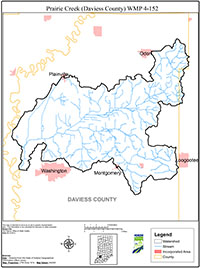Summary
Prairie Creek watershed, HUC 05120202-080, which drains into the West Fork of the White River, is located in southwestern Indiana’s Daviess County. Since 1998, the majority of the waterways within the Prairie Creek watershed have been listed on the Indiana Department of Environmental Management’s 303(d) List of Impaired Waters for repeated violations of state Water Quality Standards (WQS) due to high levels of the bacterium Escherichia coli (E. coli). WQS violations have also been issued due to high levels of the nutrients nitrogen and phosphorous, as well as impaired Biotic Community Status. In December of 2004, the Prairie Creek Watershed Planning Committee convened its first public meeting to list stakeholder issues and concerns regarding water quality. A second public meeting was held in January of 2005 to further discuss water quality issues. A third public meeting was held in April of 2005 to prioritize issues and concerns, identify sub-watershed hotspots, and set goals.
After examination of historical and current land use data, IDEM’s 305(b) and 303(d) data, the Lower White River Restoration Action Strategy, preliminary data from a Indiana Geological Survey (IGS) study being conducted in the watershed, data collected through the Hoosier Riverwatch program by the Daviess County Soil and Water Conservation District (SWCD), Long-Term Hydrologic Impact Assessment (L-THIA) and data from the National Pollutant Discharge and Elimination System (NPDES), it is believed that violations for E. coli are being caused primarily by agricultural practices and failed or failing septic systems. Nutrient pollution is largely due to agricultural practices while septic systems and home garden fertilizer application may be a secondary source. A major goal of the current plan is to reduce the amount of E. coli and nutrients reaching the streams and tributaries of the watershed by constructing manure staging facilities in accordance with NRCS standards. These manure staging facility facilities will provide livestock operators the ability to properly stage manure and therefore control E. coli and nutrient dispersal until conditions for field application are suitable. A second goal of the plan is an education/outreach program targeted at farmers, homeowners, and both small and large-scale livestock operators to inform them of the health and environmental issues caused by E. coli and nutrient pollution. Conservation practices such as grass waterways, buffer/filter strips, cover crops, and no till will be promoted and implemented in coordination with the litter staging facility construction and education/outreach programs. Success of the plan will be determined through future monitoring of chemical, biological, and physical parameters of the Prairie Creek watershed.

